Financial Accounting Report: Analysis of AASB137 for Liabilities
VerifiedAdded on 2023/03/17
|11
|2959
|39
Report
AI Summary
This report provides an in-depth analysis of financial accounting principles, specifically focusing on liabilities, including provisions and contingent liabilities, excluding lease liabilities. It examines the measurement and recognition requirements of AASB137 concerning provisions, contingent liabilities, and contingent assets. The report reviews the financial statements of Woolworths Group, an Australian-listed company, to assess the company's disclosure practices in relation to AASB137. The analysis evaluates whether Woolworths Group's measurement and recognition disclosures comply with the relevant accounting standards. The report delves into the definitions of contingent assets and liabilities, and the recognition criteria for provisions, including the obligating event and constructive obligations. It also explores the recognition of contingent liabilities, emphasizing disclosure requirements and the handling of joint obligations. Furthermore, the report examines the measurement of provisions, including the use of best estimates, the consideration of risks and uncertainties, the application of present value, and the reflection of future events and expected asset disposals. The report concludes with an assessment of Woolworths Group's compliance with AASB137, highlighting its approach to guarantees and self-insured risks.
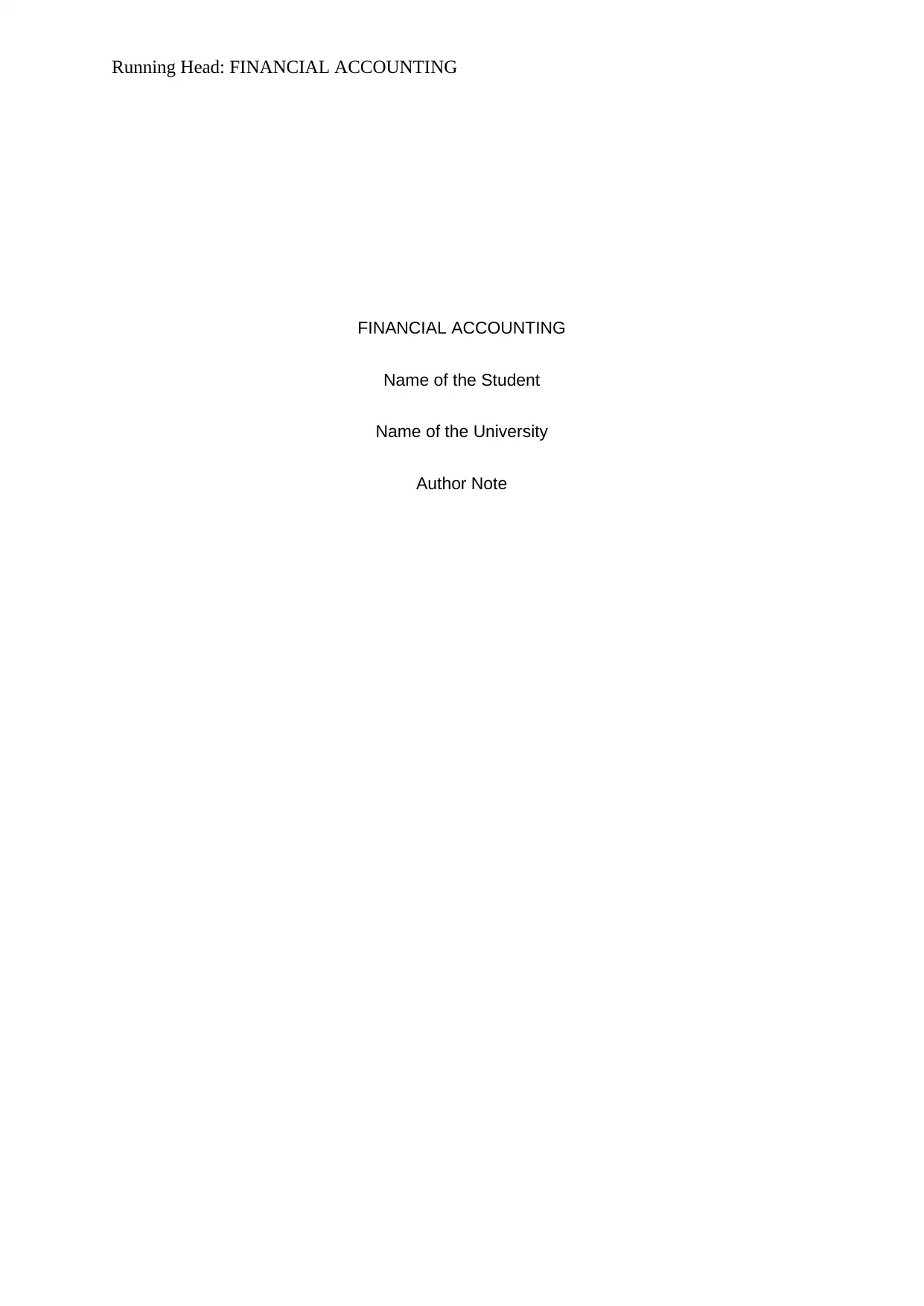
Running Head: FINANCIAL ACCOUNTING
FINANCIAL ACCOUNTING
Name of the Student
Name of the University
Author Note
FINANCIAL ACCOUNTING
Name of the Student
Name of the University
Author Note
Paraphrase This Document
Need a fresh take? Get an instant paraphrase of this document with our AI Paraphraser
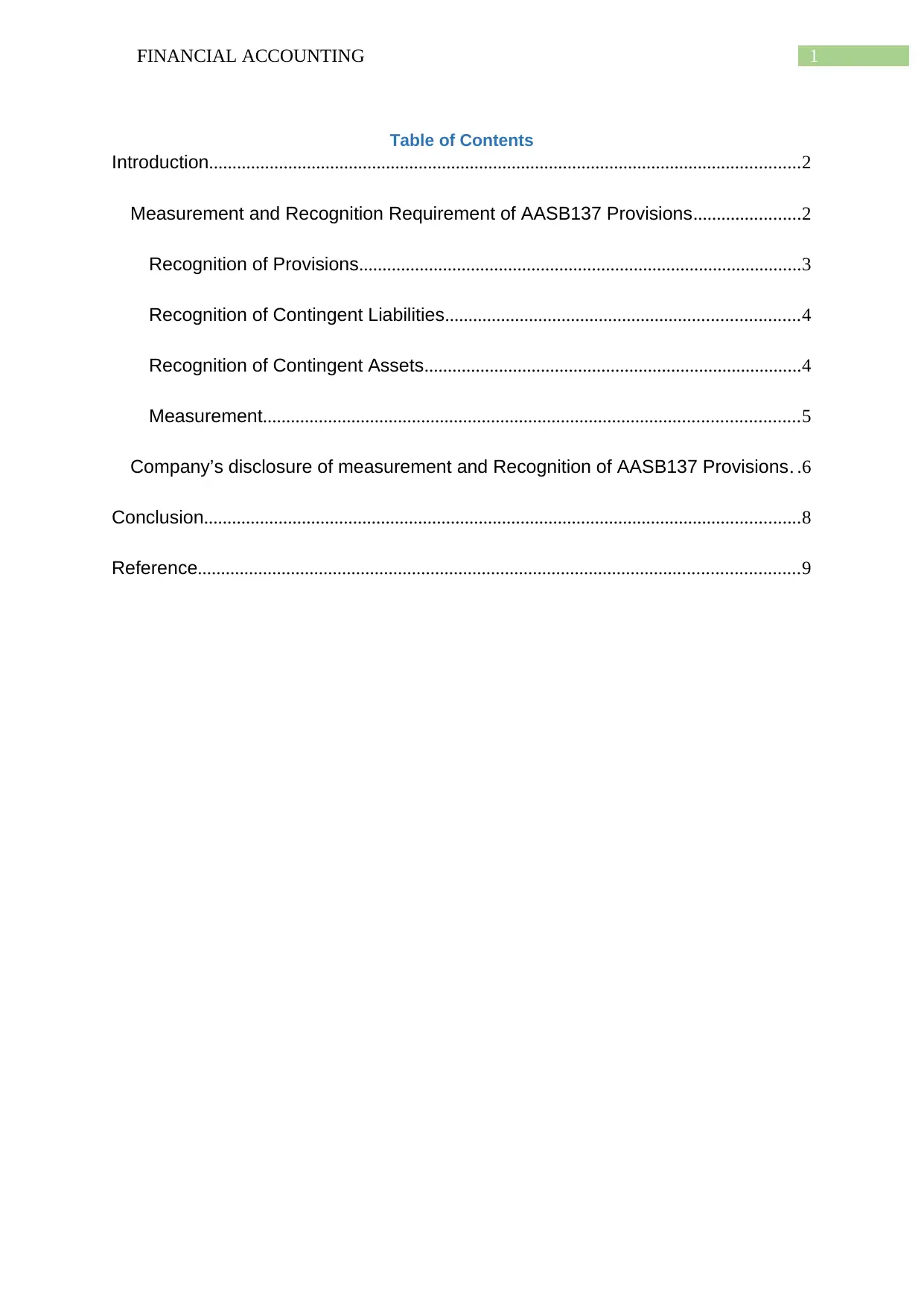
1FINANCIAL ACCOUNTING
Table of Contents
Introduction...............................................................................................................................2
Measurement and Recognition Requirement of AASB137 Provisions.......................2
Recognition of Provisions...............................................................................................3
Recognition of Contingent Liabilities............................................................................4
Recognition of Contingent Assets.................................................................................4
Measurement...................................................................................................................5
Company’s disclosure of measurement and Recognition of AASB137 Provisions. .6
Conclusion................................................................................................................................8
Reference.................................................................................................................................9
Table of Contents
Introduction...............................................................................................................................2
Measurement and Recognition Requirement of AASB137 Provisions.......................2
Recognition of Provisions...............................................................................................3
Recognition of Contingent Liabilities............................................................................4
Recognition of Contingent Assets.................................................................................4
Measurement...................................................................................................................5
Company’s disclosure of measurement and Recognition of AASB137 Provisions. .6
Conclusion................................................................................................................................8
Reference.................................................................................................................................9
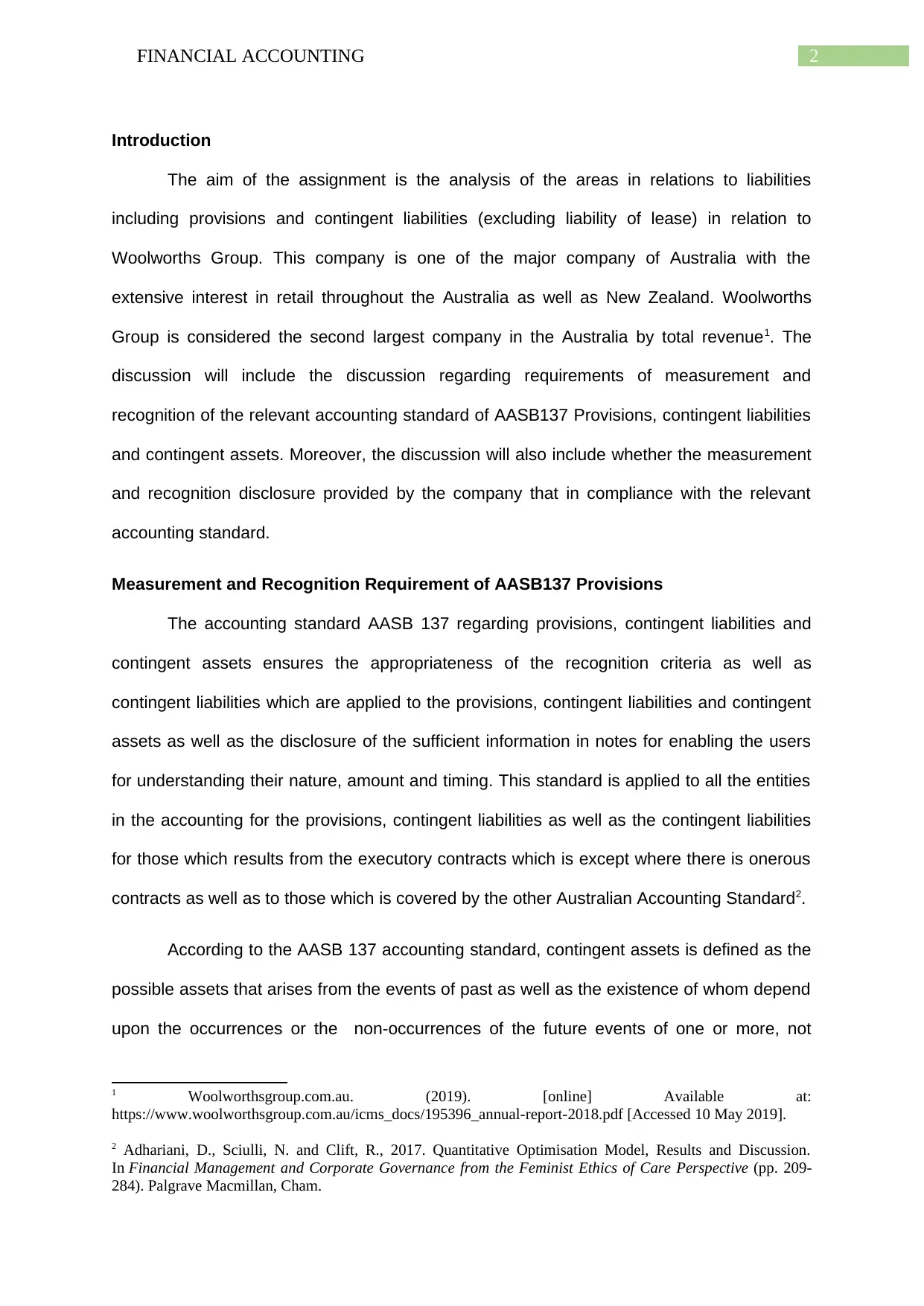
2FINANCIAL ACCOUNTING
Introduction
The aim of the assignment is the analysis of the areas in relations to liabilities
including provisions and contingent liabilities (excluding liability of lease) in relation to
Woolworths Group. This company is one of the major company of Australia with the
extensive interest in retail throughout the Australia as well as New Zealand. Woolworths
Group is considered the second largest company in the Australia by total revenue1. The
discussion will include the discussion regarding requirements of measurement and
recognition of the relevant accounting standard of AASB137 Provisions, contingent liabilities
and contingent assets. Moreover, the discussion will also include whether the measurement
and recognition disclosure provided by the company that in compliance with the relevant
accounting standard.
Measurement and Recognition Requirement of AASB137 Provisions
The accounting standard AASB 137 regarding provisions, contingent liabilities and
contingent assets ensures the appropriateness of the recognition criteria as well as
contingent liabilities which are applied to the provisions, contingent liabilities and contingent
assets as well as the disclosure of the sufficient information in notes for enabling the users
for understanding their nature, amount and timing. This standard is applied to all the entities
in the accounting for the provisions, contingent liabilities as well as the contingent liabilities
for those which results from the executory contracts which is except where there is onerous
contracts as well as to those which is covered by the other Australian Accounting Standard2.
According to the AASB 137 accounting standard, contingent assets is defined as the
possible assets that arises from the events of past as well as the existence of whom depend
upon the occurrences or the non-occurrences of the future events of one or more, not
1 Woolworthsgroup.com.au. (2019). [online] Available at:
https://www.woolworthsgroup.com.au/icms_docs/195396_annual-report-2018.pdf [Accessed 10 May 2019].
2 Adhariani, D., Sciulli, N. and Clift, R., 2017. Quantitative Optimisation Model, Results and Discussion.
In Financial Management and Corporate Governance from the Feminist Ethics of Care Perspective (pp. 209-
284). Palgrave Macmillan, Cham.
Introduction
The aim of the assignment is the analysis of the areas in relations to liabilities
including provisions and contingent liabilities (excluding liability of lease) in relation to
Woolworths Group. This company is one of the major company of Australia with the
extensive interest in retail throughout the Australia as well as New Zealand. Woolworths
Group is considered the second largest company in the Australia by total revenue1. The
discussion will include the discussion regarding requirements of measurement and
recognition of the relevant accounting standard of AASB137 Provisions, contingent liabilities
and contingent assets. Moreover, the discussion will also include whether the measurement
and recognition disclosure provided by the company that in compliance with the relevant
accounting standard.
Measurement and Recognition Requirement of AASB137 Provisions
The accounting standard AASB 137 regarding provisions, contingent liabilities and
contingent assets ensures the appropriateness of the recognition criteria as well as
contingent liabilities which are applied to the provisions, contingent liabilities and contingent
assets as well as the disclosure of the sufficient information in notes for enabling the users
for understanding their nature, amount and timing. This standard is applied to all the entities
in the accounting for the provisions, contingent liabilities as well as the contingent liabilities
for those which results from the executory contracts which is except where there is onerous
contracts as well as to those which is covered by the other Australian Accounting Standard2.
According to the AASB 137 accounting standard, contingent assets is defined as the
possible assets that arises from the events of past as well as the existence of whom depend
upon the occurrences or the non-occurrences of the future events of one or more, not
1 Woolworthsgroup.com.au. (2019). [online] Available at:
https://www.woolworthsgroup.com.au/icms_docs/195396_annual-report-2018.pdf [Accessed 10 May 2019].
2 Adhariani, D., Sciulli, N. and Clift, R., 2017. Quantitative Optimisation Model, Results and Discussion.
In Financial Management and Corporate Governance from the Feminist Ethics of Care Perspective (pp. 209-
284). Palgrave Macmillan, Cham.
⊘ This is a preview!⊘
Do you want full access?
Subscribe today to unlock all pages.

Trusted by 1+ million students worldwide
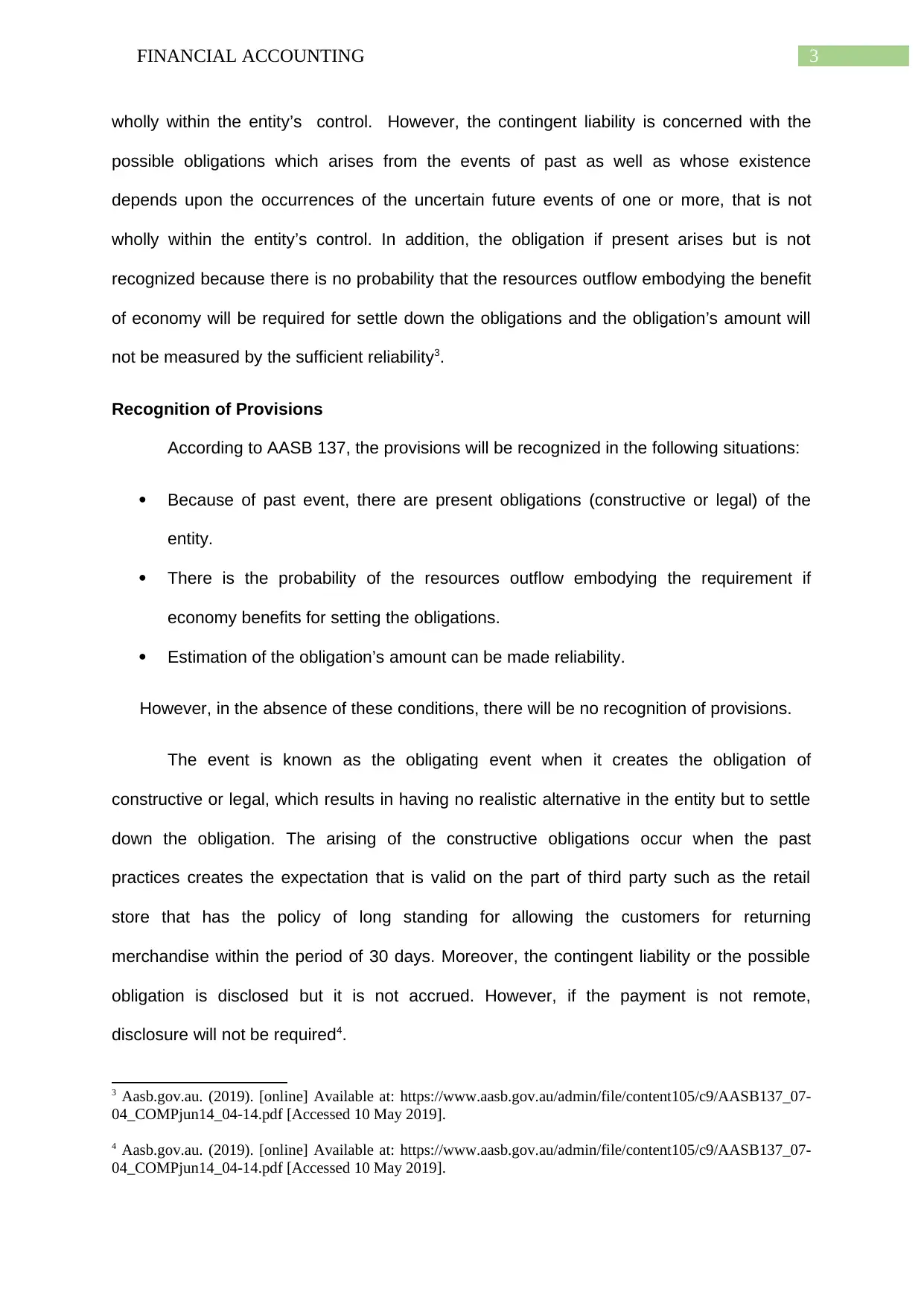
3FINANCIAL ACCOUNTING
wholly within the entity’s control. However, the contingent liability is concerned with the
possible obligations which arises from the events of past as well as whose existence
depends upon the occurrences of the uncertain future events of one or more, that is not
wholly within the entity’s control. In addition, the obligation if present arises but is not
recognized because there is no probability that the resources outflow embodying the benefit
of economy will be required for settle down the obligations and the obligation’s amount will
not be measured by the sufficient reliability3.
Recognition of Provisions
According to AASB 137, the provisions will be recognized in the following situations:
Because of past event, there are present obligations (constructive or legal) of the
entity.
There is the probability of the resources outflow embodying the requirement if
economy benefits for setting the obligations.
Estimation of the obligation’s amount can be made reliability.
However, in the absence of these conditions, there will be no recognition of provisions.
The event is known as the obligating event when it creates the obligation of
constructive or legal, which results in having no realistic alternative in the entity but to settle
down the obligation. The arising of the constructive obligations occur when the past
practices creates the expectation that is valid on the part of third party such as the retail
store that has the policy of long standing for allowing the customers for returning
merchandise within the period of 30 days. Moreover, the contingent liability or the possible
obligation is disclosed but it is not accrued. However, if the payment is not remote,
disclosure will not be required4.
3 Aasb.gov.au. (2019). [online] Available at: https://www.aasb.gov.au/admin/file/content105/c9/AASB137_07-
04_COMPjun14_04-14.pdf [Accessed 10 May 2019].
4 Aasb.gov.au. (2019). [online] Available at: https://www.aasb.gov.au/admin/file/content105/c9/AASB137_07-
04_COMPjun14_04-14.pdf [Accessed 10 May 2019].
wholly within the entity’s control. However, the contingent liability is concerned with the
possible obligations which arises from the events of past as well as whose existence
depends upon the occurrences of the uncertain future events of one or more, that is not
wholly within the entity’s control. In addition, the obligation if present arises but is not
recognized because there is no probability that the resources outflow embodying the benefit
of economy will be required for settle down the obligations and the obligation’s amount will
not be measured by the sufficient reliability3.
Recognition of Provisions
According to AASB 137, the provisions will be recognized in the following situations:
Because of past event, there are present obligations (constructive or legal) of the
entity.
There is the probability of the resources outflow embodying the requirement if
economy benefits for setting the obligations.
Estimation of the obligation’s amount can be made reliability.
However, in the absence of these conditions, there will be no recognition of provisions.
The event is known as the obligating event when it creates the obligation of
constructive or legal, which results in having no realistic alternative in the entity but to settle
down the obligation. The arising of the constructive obligations occur when the past
practices creates the expectation that is valid on the part of third party such as the retail
store that has the policy of long standing for allowing the customers for returning
merchandise within the period of 30 days. Moreover, the contingent liability or the possible
obligation is disclosed but it is not accrued. However, if the payment is not remote,
disclosure will not be required4.
3 Aasb.gov.au. (2019). [online] Available at: https://www.aasb.gov.au/admin/file/content105/c9/AASB137_07-
04_COMPjun14_04-14.pdf [Accessed 10 May 2019].
4 Aasb.gov.au. (2019). [online] Available at: https://www.aasb.gov.au/admin/file/content105/c9/AASB137_07-
04_COMPjun14_04-14.pdf [Accessed 10 May 2019].
Paraphrase This Document
Need a fresh take? Get an instant paraphrase of this document with our AI Paraphraser
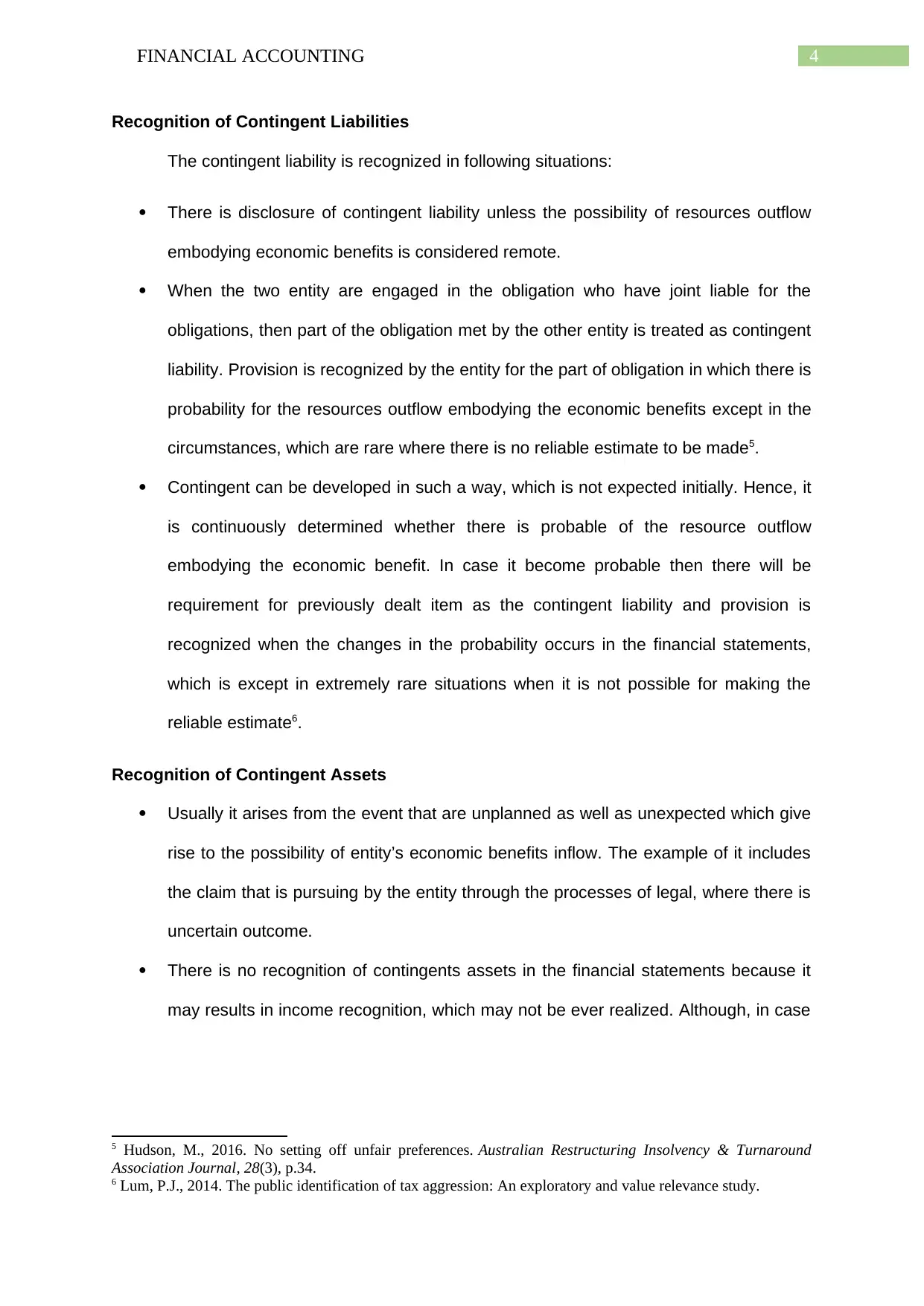
4FINANCIAL ACCOUNTING
Recognition of Contingent Liabilities
The contingent liability is recognized in following situations:
There is disclosure of contingent liability unless the possibility of resources outflow
embodying economic benefits is considered remote.
When the two entity are engaged in the obligation who have joint liable for the
obligations, then part of the obligation met by the other entity is treated as contingent
liability. Provision is recognized by the entity for the part of obligation in which there is
probability for the resources outflow embodying the economic benefits except in the
circumstances, which are rare where there is no reliable estimate to be made5.
Contingent can be developed in such a way, which is not expected initially. Hence, it
is continuously determined whether there is probable of the resource outflow
embodying the economic benefit. In case it become probable then there will be
requirement for previously dealt item as the contingent liability and provision is
recognized when the changes in the probability occurs in the financial statements,
which is except in extremely rare situations when it is not possible for making the
reliable estimate6.
Recognition of Contingent Assets
Usually it arises from the event that are unplanned as well as unexpected which give
rise to the possibility of entity’s economic benefits inflow. The example of it includes
the claim that is pursuing by the entity through the processes of legal, where there is
uncertain outcome.
There is no recognition of contingents assets in the financial statements because it
may results in income recognition, which may not be ever realized. Although, in case
5 Hudson, M., 2016. No setting off unfair preferences. Australian Restructuring Insolvency & Turnaround
Association Journal, 28(3), p.34.
6 Lum, P.J., 2014. The public identification of tax aggression: An exploratory and value relevance study.
Recognition of Contingent Liabilities
The contingent liability is recognized in following situations:
There is disclosure of contingent liability unless the possibility of resources outflow
embodying economic benefits is considered remote.
When the two entity are engaged in the obligation who have joint liable for the
obligations, then part of the obligation met by the other entity is treated as contingent
liability. Provision is recognized by the entity for the part of obligation in which there is
probability for the resources outflow embodying the economic benefits except in the
circumstances, which are rare where there is no reliable estimate to be made5.
Contingent can be developed in such a way, which is not expected initially. Hence, it
is continuously determined whether there is probable of the resource outflow
embodying the economic benefit. In case it become probable then there will be
requirement for previously dealt item as the contingent liability and provision is
recognized when the changes in the probability occurs in the financial statements,
which is except in extremely rare situations when it is not possible for making the
reliable estimate6.
Recognition of Contingent Assets
Usually it arises from the event that are unplanned as well as unexpected which give
rise to the possibility of entity’s economic benefits inflow. The example of it includes
the claim that is pursuing by the entity through the processes of legal, where there is
uncertain outcome.
There is no recognition of contingents assets in the financial statements because it
may results in income recognition, which may not be ever realized. Although, in case
5 Hudson, M., 2016. No setting off unfair preferences. Australian Restructuring Insolvency & Turnaround
Association Journal, 28(3), p.34.
6 Lum, P.J., 2014. The public identification of tax aggression: An exploratory and value relevance study.
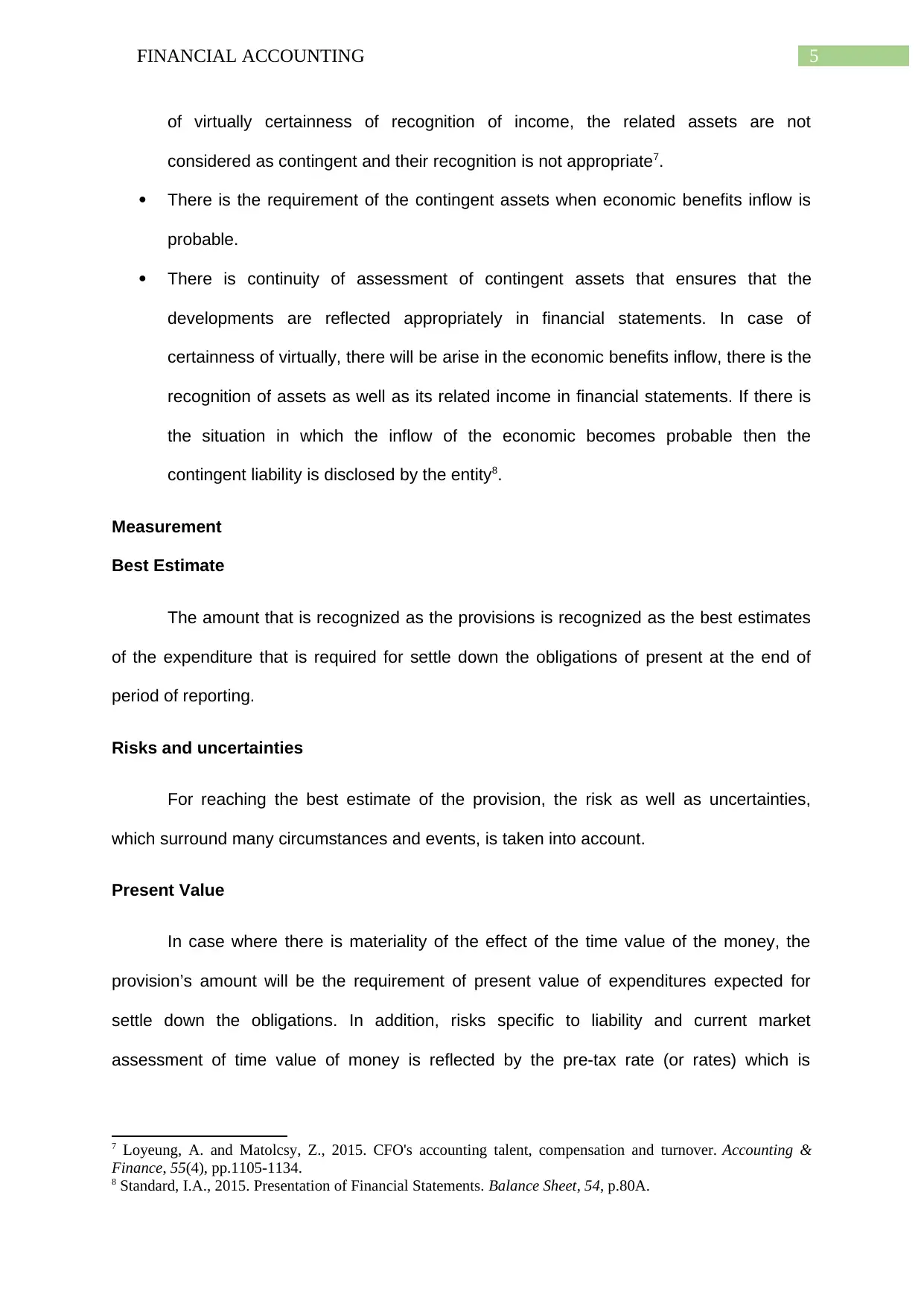
5FINANCIAL ACCOUNTING
of virtually certainness of recognition of income, the related assets are not
considered as contingent and their recognition is not appropriate7.
There is the requirement of the contingent assets when economic benefits inflow is
probable.
There is continuity of assessment of contingent assets that ensures that the
developments are reflected appropriately in financial statements. In case of
certainness of virtually, there will be arise in the economic benefits inflow, there is the
recognition of assets as well as its related income in financial statements. If there is
the situation in which the inflow of the economic becomes probable then the
contingent liability is disclosed by the entity8.
Measurement
Best Estimate
The amount that is recognized as the provisions is recognized as the best estimates
of the expenditure that is required for settle down the obligations of present at the end of
period of reporting.
Risks and uncertainties
For reaching the best estimate of the provision, the risk as well as uncertainties,
which surround many circumstances and events, is taken into account.
Present Value
In case where there is materiality of the effect of the time value of the money, the
provision’s amount will be the requirement of present value of expenditures expected for
settle down the obligations. In addition, risks specific to liability and current market
assessment of time value of money is reflected by the pre-tax rate (or rates) which is
7 Loyeung, A. and Matolcsy, Z., 2015. CFO's accounting talent, compensation and turnover. Accounting &
Finance, 55(4), pp.1105-1134.
8 Standard, I.A., 2015. Presentation of Financial Statements. Balance Sheet, 54, p.80A.
of virtually certainness of recognition of income, the related assets are not
considered as contingent and their recognition is not appropriate7.
There is the requirement of the contingent assets when economic benefits inflow is
probable.
There is continuity of assessment of contingent assets that ensures that the
developments are reflected appropriately in financial statements. In case of
certainness of virtually, there will be arise in the economic benefits inflow, there is the
recognition of assets as well as its related income in financial statements. If there is
the situation in which the inflow of the economic becomes probable then the
contingent liability is disclosed by the entity8.
Measurement
Best Estimate
The amount that is recognized as the provisions is recognized as the best estimates
of the expenditure that is required for settle down the obligations of present at the end of
period of reporting.
Risks and uncertainties
For reaching the best estimate of the provision, the risk as well as uncertainties,
which surround many circumstances and events, is taken into account.
Present Value
In case where there is materiality of the effect of the time value of the money, the
provision’s amount will be the requirement of present value of expenditures expected for
settle down the obligations. In addition, risks specific to liability and current market
assessment of time value of money is reflected by the pre-tax rate (or rates) which is
7 Loyeung, A. and Matolcsy, Z., 2015. CFO's accounting talent, compensation and turnover. Accounting &
Finance, 55(4), pp.1105-1134.
8 Standard, I.A., 2015. Presentation of Financial Statements. Balance Sheet, 54, p.80A.
⊘ This is a preview!⊘
Do you want full access?
Subscribe today to unlock all pages.

Trusted by 1+ million students worldwide
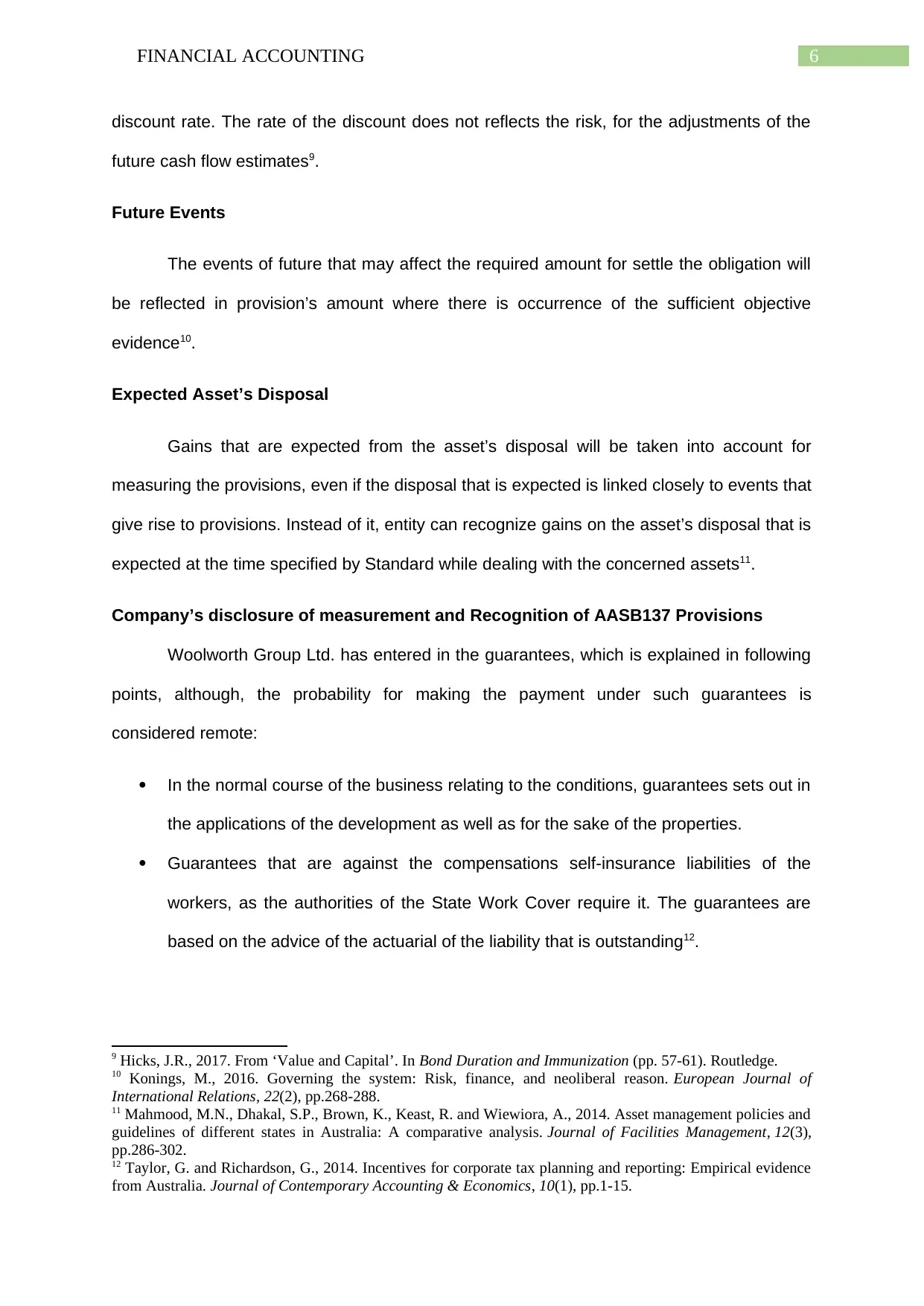
6FINANCIAL ACCOUNTING
discount rate. The rate of the discount does not reflects the risk, for the adjustments of the
future cash flow estimates9.
Future Events
The events of future that may affect the required amount for settle the obligation will
be reflected in provision’s amount where there is occurrence of the sufficient objective
evidence10.
Expected Asset’s Disposal
Gains that are expected from the asset’s disposal will be taken into account for
measuring the provisions, even if the disposal that is expected is linked closely to events that
give rise to provisions. Instead of it, entity can recognize gains on the asset’s disposal that is
expected at the time specified by Standard while dealing with the concerned assets11.
Company’s disclosure of measurement and Recognition of AASB137 Provisions
Woolworth Group Ltd. has entered in the guarantees, which is explained in following
points, although, the probability for making the payment under such guarantees is
considered remote:
In the normal course of the business relating to the conditions, guarantees sets out in
the applications of the development as well as for the sake of the properties.
Guarantees that are against the compensations self-insurance liabilities of the
workers, as the authorities of the State Work Cover require it. The guarantees are
based on the advice of the actuarial of the liability that is outstanding12.
9 Hicks, J.R., 2017. From ‘Value and Capital’. In Bond Duration and Immunization (pp. 57-61). Routledge.
10 Konings, M., 2016. Governing the system: Risk, finance, and neoliberal reason. European Journal of
International Relations, 22(2), pp.268-288.
11 Mahmood, M.N., Dhakal, S.P., Brown, K., Keast, R. and Wiewiora, A., 2014. Asset management policies and
guidelines of different states in Australia: A comparative analysis. Journal of Facilities Management, 12(3),
pp.286-302.
12 Taylor, G. and Richardson, G., 2014. Incentives for corporate tax planning and reporting: Empirical evidence
from Australia. Journal of Contemporary Accounting & Economics, 10(1), pp.1-15.
discount rate. The rate of the discount does not reflects the risk, for the adjustments of the
future cash flow estimates9.
Future Events
The events of future that may affect the required amount for settle the obligation will
be reflected in provision’s amount where there is occurrence of the sufficient objective
evidence10.
Expected Asset’s Disposal
Gains that are expected from the asset’s disposal will be taken into account for
measuring the provisions, even if the disposal that is expected is linked closely to events that
give rise to provisions. Instead of it, entity can recognize gains on the asset’s disposal that is
expected at the time specified by Standard while dealing with the concerned assets11.
Company’s disclosure of measurement and Recognition of AASB137 Provisions
Woolworth Group Ltd. has entered in the guarantees, which is explained in following
points, although, the probability for making the payment under such guarantees is
considered remote:
In the normal course of the business relating to the conditions, guarantees sets out in
the applications of the development as well as for the sake of the properties.
Guarantees that are against the compensations self-insurance liabilities of the
workers, as the authorities of the State Work Cover require it. The guarantees are
based on the advice of the actuarial of the liability that is outstanding12.
9 Hicks, J.R., 2017. From ‘Value and Capital’. In Bond Duration and Immunization (pp. 57-61). Routledge.
10 Konings, M., 2016. Governing the system: Risk, finance, and neoliberal reason. European Journal of
International Relations, 22(2), pp.268-288.
11 Mahmood, M.N., Dhakal, S.P., Brown, K., Keast, R. and Wiewiora, A., 2014. Asset management policies and
guidelines of different states in Australia: A comparative analysis. Journal of Facilities Management, 12(3),
pp.286-302.
12 Taylor, G. and Richardson, G., 2014. Incentives for corporate tax planning and reporting: Empirical evidence
from Australia. Journal of Contemporary Accounting & Economics, 10(1), pp.1-15.
Paraphrase This Document
Need a fresh take? Get an instant paraphrase of this document with our AI Paraphraser
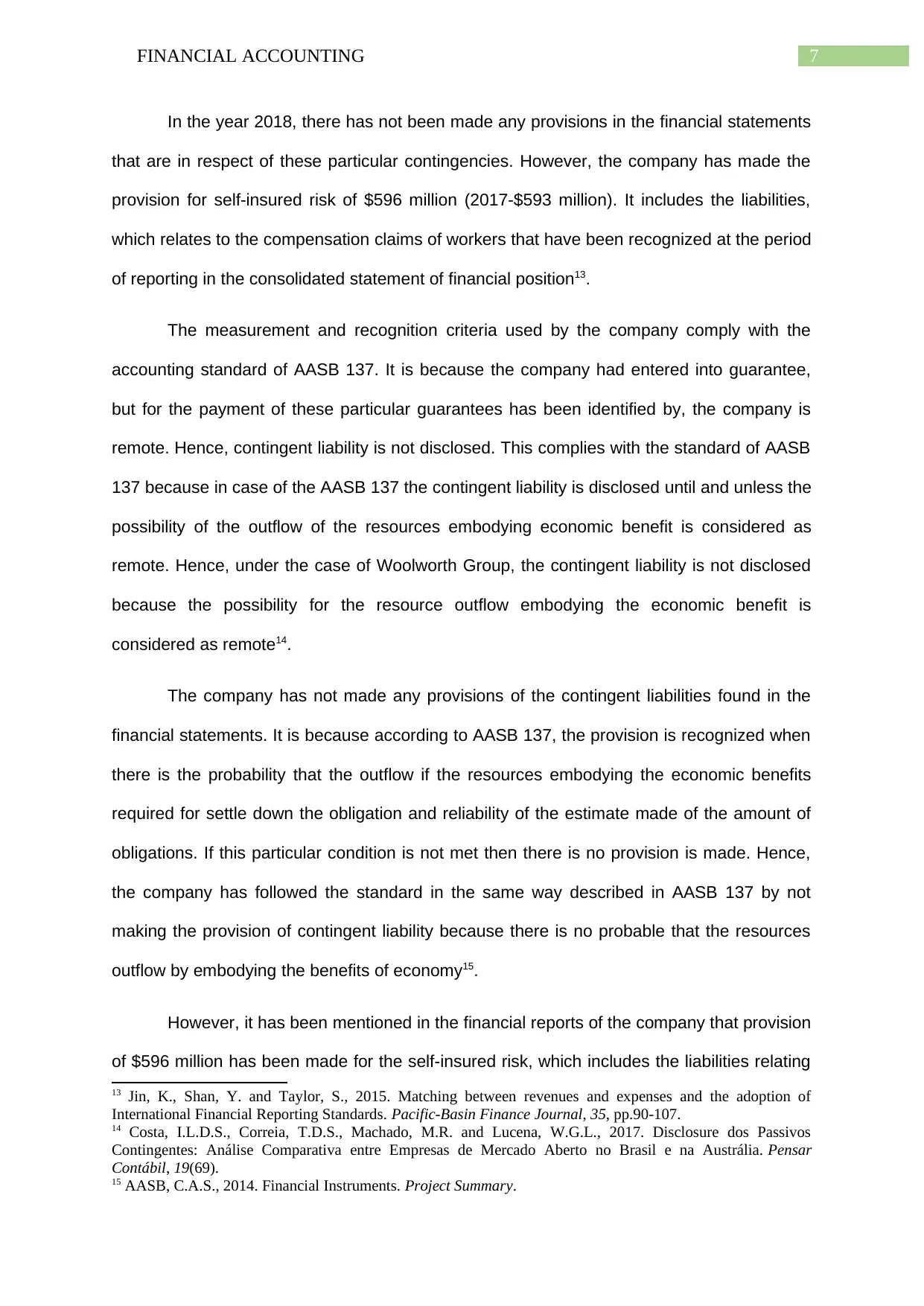
7FINANCIAL ACCOUNTING
In the year 2018, there has not been made any provisions in the financial statements
that are in respect of these particular contingencies. However, the company has made the
provision for self-insured risk of $596 million (2017-$593 million). It includes the liabilities,
which relates to the compensation claims of workers that have been recognized at the period
of reporting in the consolidated statement of financial position13.
The measurement and recognition criteria used by the company comply with the
accounting standard of AASB 137. It is because the company had entered into guarantee,
but for the payment of these particular guarantees has been identified by, the company is
remote. Hence, contingent liability is not disclosed. This complies with the standard of AASB
137 because in case of the AASB 137 the contingent liability is disclosed until and unless the
possibility of the outflow of the resources embodying economic benefit is considered as
remote. Hence, under the case of Woolworth Group, the contingent liability is not disclosed
because the possibility for the resource outflow embodying the economic benefit is
considered as remote14.
The company has not made any provisions of the contingent liabilities found in the
financial statements. It is because according to AASB 137, the provision is recognized when
there is the probability that the outflow if the resources embodying the economic benefits
required for settle down the obligation and reliability of the estimate made of the amount of
obligations. If this particular condition is not met then there is no provision is made. Hence,
the company has followed the standard in the same way described in AASB 137 by not
making the provision of contingent liability because there is no probable that the resources
outflow by embodying the benefits of economy15.
However, it has been mentioned in the financial reports of the company that provision
of $596 million has been made for the self-insured risk, which includes the liabilities relating
13 Jin, K., Shan, Y. and Taylor, S., 2015. Matching between revenues and expenses and the adoption of
International Financial Reporting Standards. Pacific-Basin Finance Journal, 35, pp.90-107.
14 Costa, I.L.D.S., Correia, T.D.S., Machado, M.R. and Lucena, W.G.L., 2017. Disclosure dos Passivos
Contingentes: Análise Comparativa entre Empresas de Mercado Aberto no Brasil e na Austrália. Pensar
Contábil, 19(69).
15 AASB, C.A.S., 2014. Financial Instruments. Project Summary.
In the year 2018, there has not been made any provisions in the financial statements
that are in respect of these particular contingencies. However, the company has made the
provision for self-insured risk of $596 million (2017-$593 million). It includes the liabilities,
which relates to the compensation claims of workers that have been recognized at the period
of reporting in the consolidated statement of financial position13.
The measurement and recognition criteria used by the company comply with the
accounting standard of AASB 137. It is because the company had entered into guarantee,
but for the payment of these particular guarantees has been identified by, the company is
remote. Hence, contingent liability is not disclosed. This complies with the standard of AASB
137 because in case of the AASB 137 the contingent liability is disclosed until and unless the
possibility of the outflow of the resources embodying economic benefit is considered as
remote. Hence, under the case of Woolworth Group, the contingent liability is not disclosed
because the possibility for the resource outflow embodying the economic benefit is
considered as remote14.
The company has not made any provisions of the contingent liabilities found in the
financial statements. It is because according to AASB 137, the provision is recognized when
there is the probability that the outflow if the resources embodying the economic benefits
required for settle down the obligation and reliability of the estimate made of the amount of
obligations. If this particular condition is not met then there is no provision is made. Hence,
the company has followed the standard in the same way described in AASB 137 by not
making the provision of contingent liability because there is no probable that the resources
outflow by embodying the benefits of economy15.
However, it has been mentioned in the financial reports of the company that provision
of $596 million has been made for the self-insured risk, which includes the liabilities relating
13 Jin, K., Shan, Y. and Taylor, S., 2015. Matching between revenues and expenses and the adoption of
International Financial Reporting Standards. Pacific-Basin Finance Journal, 35, pp.90-107.
14 Costa, I.L.D.S., Correia, T.D.S., Machado, M.R. and Lucena, W.G.L., 2017. Disclosure dos Passivos
Contingentes: Análise Comparativa entre Empresas de Mercado Aberto no Brasil e na Austrália. Pensar
Contábil, 19(69).
15 AASB, C.A.S., 2014. Financial Instruments. Project Summary.
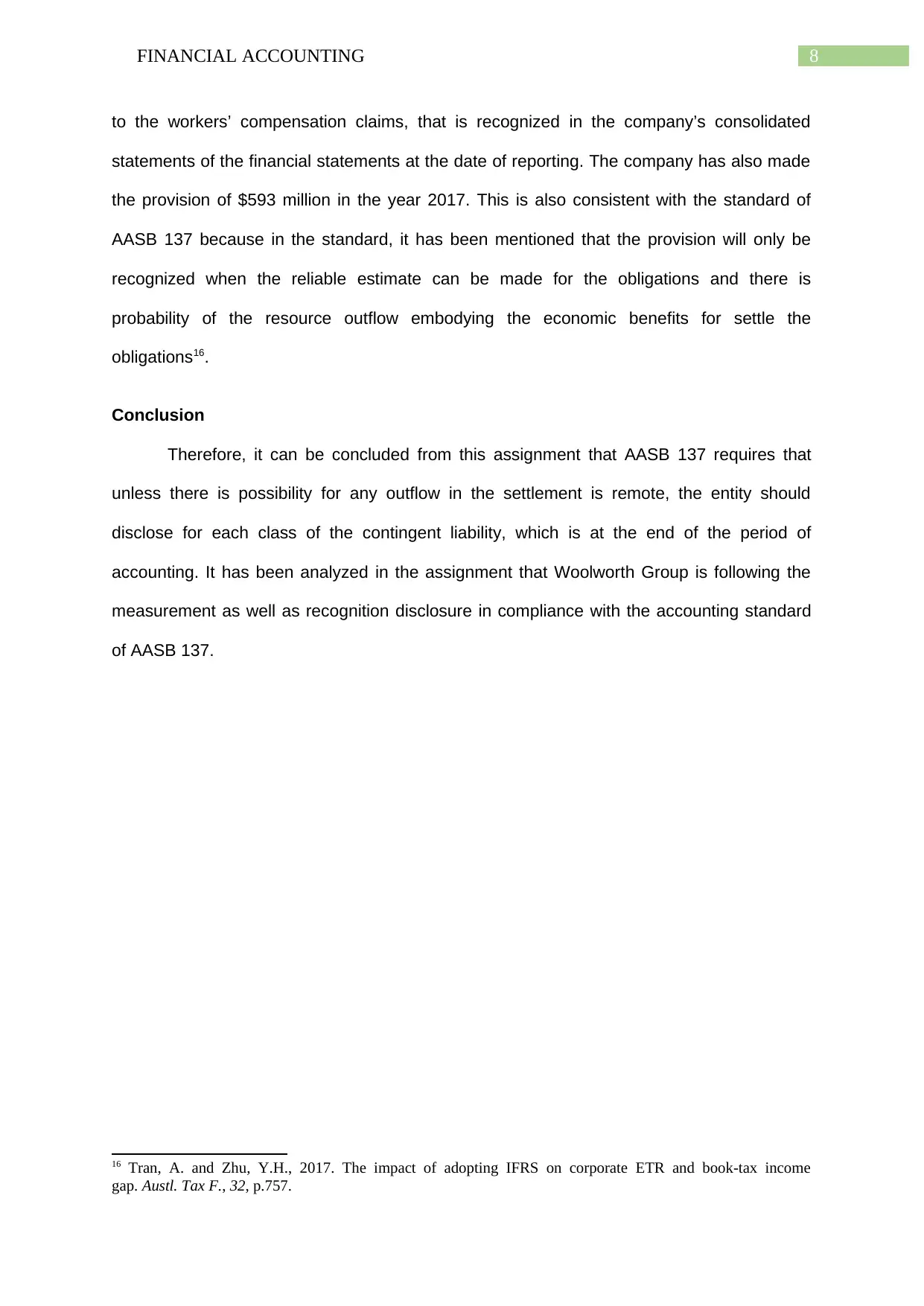
8FINANCIAL ACCOUNTING
to the workers’ compensation claims, that is recognized in the company’s consolidated
statements of the financial statements at the date of reporting. The company has also made
the provision of $593 million in the year 2017. This is also consistent with the standard of
AASB 137 because in the standard, it has been mentioned that the provision will only be
recognized when the reliable estimate can be made for the obligations and there is
probability of the resource outflow embodying the economic benefits for settle the
obligations16.
Conclusion
Therefore, it can be concluded from this assignment that AASB 137 requires that
unless there is possibility for any outflow in the settlement is remote, the entity should
disclose for each class of the contingent liability, which is at the end of the period of
accounting. It has been analyzed in the assignment that Woolworth Group is following the
measurement as well as recognition disclosure in compliance with the accounting standard
of AASB 137.
16 Tran, A. and Zhu, Y.H., 2017. The impact of adopting IFRS on corporate ETR and book-tax income
gap. Austl. Tax F., 32, p.757.
to the workers’ compensation claims, that is recognized in the company’s consolidated
statements of the financial statements at the date of reporting. The company has also made
the provision of $593 million in the year 2017. This is also consistent with the standard of
AASB 137 because in the standard, it has been mentioned that the provision will only be
recognized when the reliable estimate can be made for the obligations and there is
probability of the resource outflow embodying the economic benefits for settle the
obligations16.
Conclusion
Therefore, it can be concluded from this assignment that AASB 137 requires that
unless there is possibility for any outflow in the settlement is remote, the entity should
disclose for each class of the contingent liability, which is at the end of the period of
accounting. It has been analyzed in the assignment that Woolworth Group is following the
measurement as well as recognition disclosure in compliance with the accounting standard
of AASB 137.
16 Tran, A. and Zhu, Y.H., 2017. The impact of adopting IFRS on corporate ETR and book-tax income
gap. Austl. Tax F., 32, p.757.
⊘ This is a preview!⊘
Do you want full access?
Subscribe today to unlock all pages.

Trusted by 1+ million students worldwide
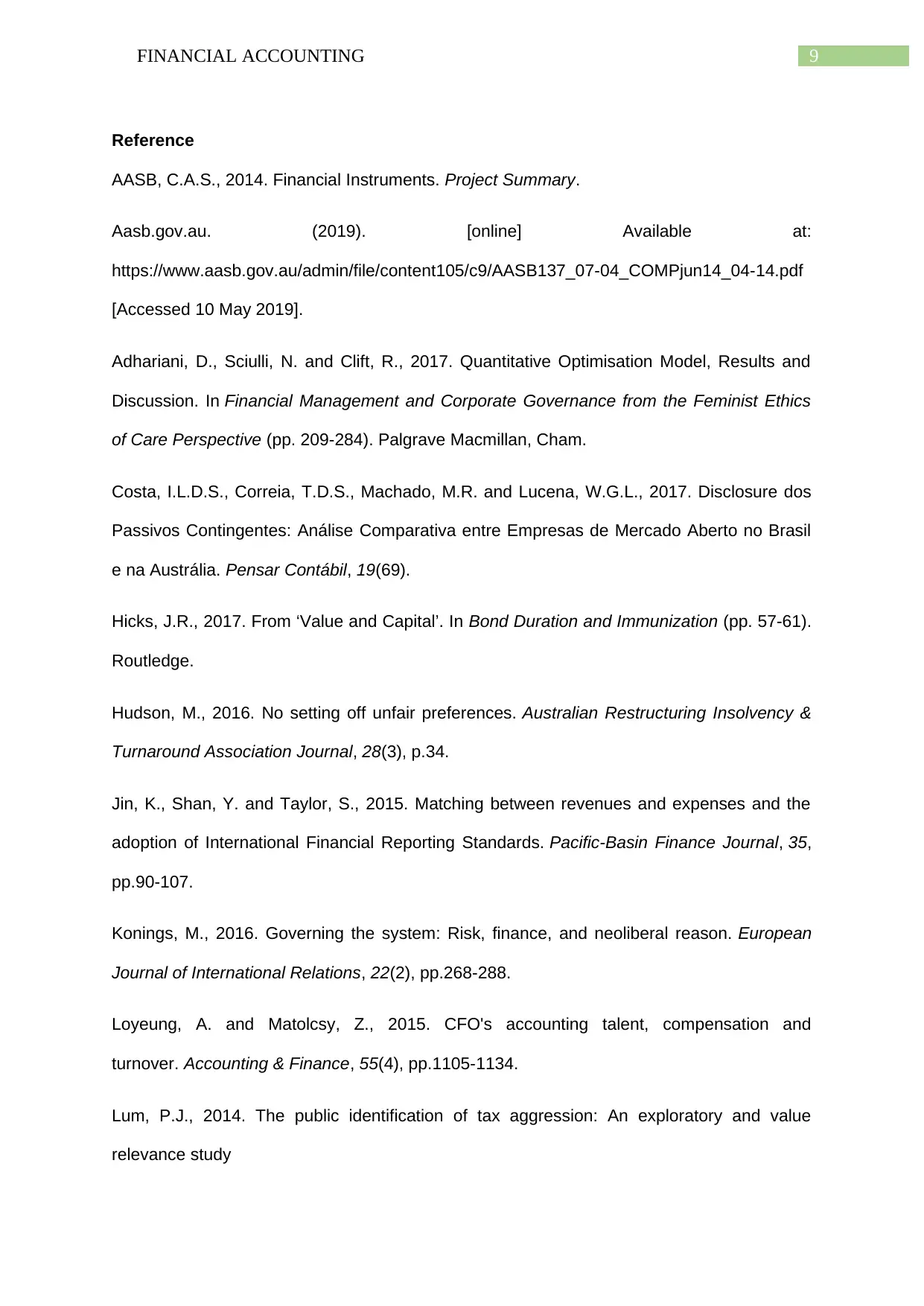
9FINANCIAL ACCOUNTING
Reference
AASB, C.A.S., 2014. Financial Instruments. Project Summary.
Aasb.gov.au. (2019). [online] Available at:
https://www.aasb.gov.au/admin/file/content105/c9/AASB137_07-04_COMPjun14_04-14.pdf
[Accessed 10 May 2019].
Adhariani, D., Sciulli, N. and Clift, R., 2017. Quantitative Optimisation Model, Results and
Discussion. In Financial Management and Corporate Governance from the Feminist Ethics
of Care Perspective (pp. 209-284). Palgrave Macmillan, Cham.
Costa, I.L.D.S., Correia, T.D.S., Machado, M.R. and Lucena, W.G.L., 2017. Disclosure dos
Passivos Contingentes: Análise Comparativa entre Empresas de Mercado Aberto no Brasil
e na Austrália. Pensar Contábil, 19(69).
Hicks, J.R., 2017. From ‘Value and Capital’. In Bond Duration and Immunization (pp. 57-61).
Routledge.
Hudson, M., 2016. No setting off unfair preferences. Australian Restructuring Insolvency &
Turnaround Association Journal, 28(3), p.34.
Jin, K., Shan, Y. and Taylor, S., 2015. Matching between revenues and expenses and the
adoption of International Financial Reporting Standards. Pacific-Basin Finance Journal, 35,
pp.90-107.
Konings, M., 2016. Governing the system: Risk, finance, and neoliberal reason. European
Journal of International Relations, 22(2), pp.268-288.
Loyeung, A. and Matolcsy, Z., 2015. CFO's accounting talent, compensation and
turnover. Accounting & Finance, 55(4), pp.1105-1134.
Lum, P.J., 2014. The public identification of tax aggression: An exploratory and value
relevance study
Reference
AASB, C.A.S., 2014. Financial Instruments. Project Summary.
Aasb.gov.au. (2019). [online] Available at:
https://www.aasb.gov.au/admin/file/content105/c9/AASB137_07-04_COMPjun14_04-14.pdf
[Accessed 10 May 2019].
Adhariani, D., Sciulli, N. and Clift, R., 2017. Quantitative Optimisation Model, Results and
Discussion. In Financial Management and Corporate Governance from the Feminist Ethics
of Care Perspective (pp. 209-284). Palgrave Macmillan, Cham.
Costa, I.L.D.S., Correia, T.D.S., Machado, M.R. and Lucena, W.G.L., 2017. Disclosure dos
Passivos Contingentes: Análise Comparativa entre Empresas de Mercado Aberto no Brasil
e na Austrália. Pensar Contábil, 19(69).
Hicks, J.R., 2017. From ‘Value and Capital’. In Bond Duration and Immunization (pp. 57-61).
Routledge.
Hudson, M., 2016. No setting off unfair preferences. Australian Restructuring Insolvency &
Turnaround Association Journal, 28(3), p.34.
Jin, K., Shan, Y. and Taylor, S., 2015. Matching between revenues and expenses and the
adoption of International Financial Reporting Standards. Pacific-Basin Finance Journal, 35,
pp.90-107.
Konings, M., 2016. Governing the system: Risk, finance, and neoliberal reason. European
Journal of International Relations, 22(2), pp.268-288.
Loyeung, A. and Matolcsy, Z., 2015. CFO's accounting talent, compensation and
turnover. Accounting & Finance, 55(4), pp.1105-1134.
Lum, P.J., 2014. The public identification of tax aggression: An exploratory and value
relevance study
Paraphrase This Document
Need a fresh take? Get an instant paraphrase of this document with our AI Paraphraser
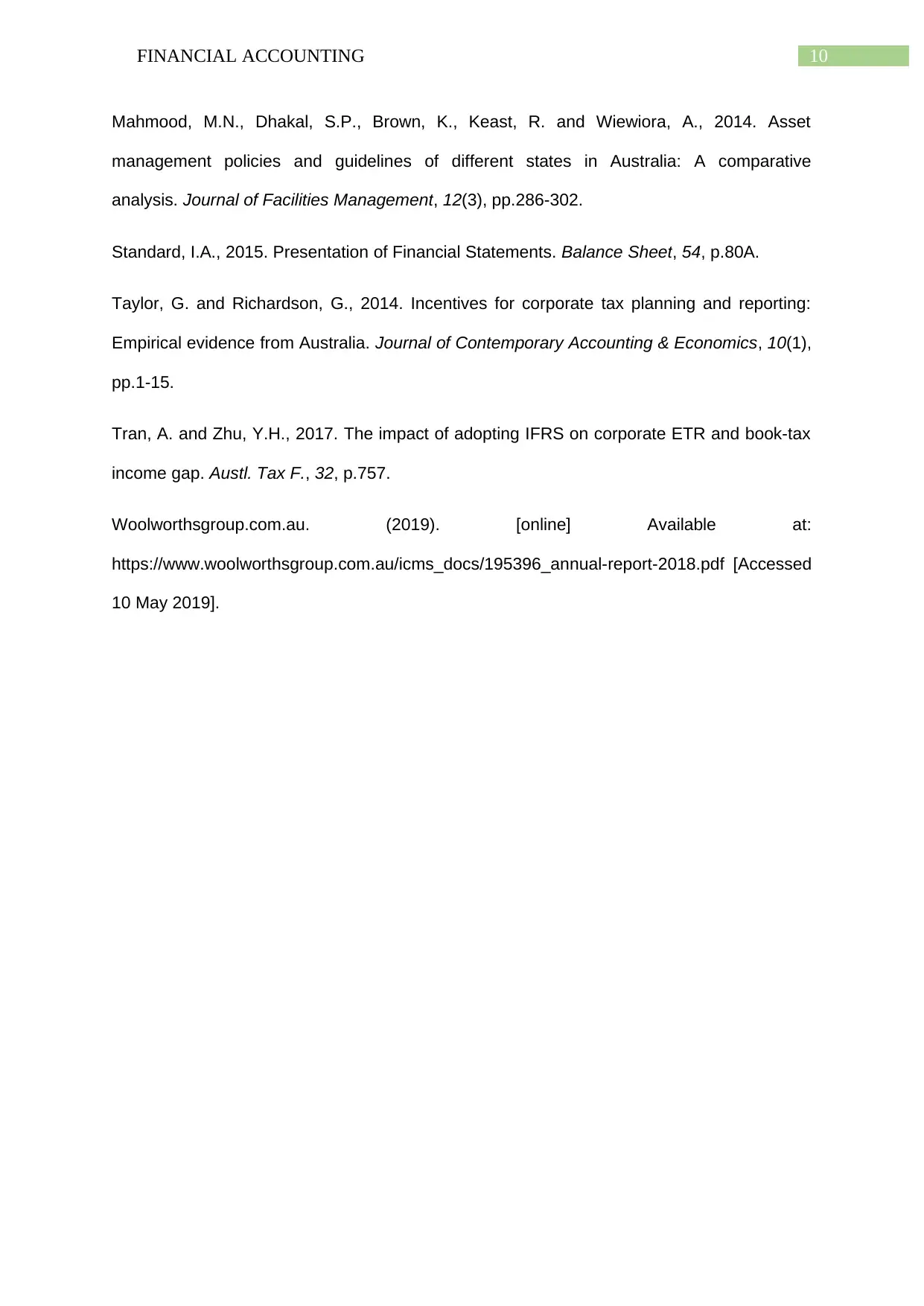
10FINANCIAL ACCOUNTING
Mahmood, M.N., Dhakal, S.P., Brown, K., Keast, R. and Wiewiora, A., 2014. Asset
management policies and guidelines of different states in Australia: A comparative
analysis. Journal of Facilities Management, 12(3), pp.286-302.
Standard, I.A., 2015. Presentation of Financial Statements. Balance Sheet, 54, p.80A.
Taylor, G. and Richardson, G., 2014. Incentives for corporate tax planning and reporting:
Empirical evidence from Australia. Journal of Contemporary Accounting & Economics, 10(1),
pp.1-15.
Tran, A. and Zhu, Y.H., 2017. The impact of adopting IFRS on corporate ETR and book-tax
income gap. Austl. Tax F., 32, p.757.
Woolworthsgroup.com.au. (2019). [online] Available at:
https://www.woolworthsgroup.com.au/icms_docs/195396_annual-report-2018.pdf [Accessed
10 May 2019].
Mahmood, M.N., Dhakal, S.P., Brown, K., Keast, R. and Wiewiora, A., 2014. Asset
management policies and guidelines of different states in Australia: A comparative
analysis. Journal of Facilities Management, 12(3), pp.286-302.
Standard, I.A., 2015. Presentation of Financial Statements. Balance Sheet, 54, p.80A.
Taylor, G. and Richardson, G., 2014. Incentives for corporate tax planning and reporting:
Empirical evidence from Australia. Journal of Contemporary Accounting & Economics, 10(1),
pp.1-15.
Tran, A. and Zhu, Y.H., 2017. The impact of adopting IFRS on corporate ETR and book-tax
income gap. Austl. Tax F., 32, p.757.
Woolworthsgroup.com.au. (2019). [online] Available at:
https://www.woolworthsgroup.com.au/icms_docs/195396_annual-report-2018.pdf [Accessed
10 May 2019].
1 out of 11
Related Documents
Your All-in-One AI-Powered Toolkit for Academic Success.
+13062052269
info@desklib.com
Available 24*7 on WhatsApp / Email
![[object Object]](/_next/static/media/star-bottom.7253800d.svg)
Unlock your academic potential
Copyright © 2020–2025 A2Z Services. All Rights Reserved. Developed and managed by ZUCOL.





